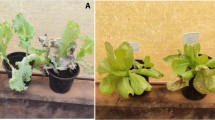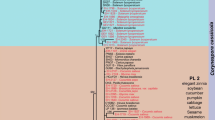Abstract
The root-associated fungus LtVB3 was formerly reported as a potential, new biocontrol agent of Verticillium yellows of Chinese cabbage and Fusarium wilt of tomato. According to molecular phylogenetic analysis of the ITS 1-5.8S rDNA-ITS 2 gene regions and morphological characteristics, LtVB3 is here identified as Meliniomyces variabilis, a recently described species [formerly called “Variable White Taxon” (VWT)] in a new genus erected to accommodate sterile fungi with phylogenetic affinities to Rhizoscyphus ericae, an ericoid mycorrhizal fungus. In vitro inoculation experiments showed that LtVB3 colonized the roots of torch azalea and eucalyptus; however, growth was enhanced only in azalea but not in eucalyptus. Hyphae of M. variabilis formed intracellular structures typical of ericoid mycorrhizas in epidermal cells of azalea roots but did not produce any typical ectomycorrhizal structures with or within root cells of either host. In LtVB3-treated eucalyptus roots, some cells in the epidermal and cortical layers had wall appositions and thickenings, which appeared to restrict fungal growth.




Similar content being viewed by others
References
Addy HD, Hambleton S, Currah RS (2000) Distribution and molecular characterization of the root endophyte Phialocephala fortinii along an environmental gradient in the boreal forest of Alberta. Mycol Res 104:1213–1221 doi:10.1017/S0953756200002896
Addy HD, Piercey MM, Currah RS (2005) Microfungal endophytes in roots. Can J Bot 83:1–13 doi:10.1139/b04-171
Dalpé Y (1986) Axenic synthesis of ericoid mycorrhiza in Vaccinium angustifolium Ait. by Oidiodendron species. New Phytol 103:391–396 doi:10.1111/j.1469-8137.1986.tb00624.x
Dalpé Y (1989) Ericoid mycorrhizal fungi in the Myxotrichaceae and Gymnoascaceae. New Phytol 113:523–527 doi:10.1111/j.1469-8137.1989.tb00364.x
Dalpé Y (1991) Statut endomycorhizien du genre Oidiodendron. Can J Bot 69:1712–1714
Dalpé Y, Litten W, Sigler L (1989) Scytalidium vaccinii sp. nov., an ericoid endophyte of Vaccinium angustifolium roots. Mycotaxon 35:371–377
Douglas GC, Heslin MC, Reid C (1989) Isolation of Oidiodendron maius from Rhododendron and ultrastructural characterization of synthesized mycorrhizas. Can J Bot 67:2206–2212
Egger KN, Sigler L (1993) Relatedness of the ericoid endophytes Scytalidium vaccinii and Hymenoscyphus ericae inferred from analysis of ribosomal DNA. Mycologia 85:219–230
Felsenstein J (1985) Confidence limits on phylogenies: an approach using the bootstrap. Evolution 39:783–791
Fernando AA, Currah RS (1996) A comparative study of the effects of the root endophytes Leptodontidium orchidicola and Phialocephala fortinii (Fungi Imperfecti) on the growth of some subalpine plants in culture. Can J Bot 74:1071–1078
Grünig CR, Sieber TN, Rogers SO, Holdenrieder O (2002) Genetic variability among strains of Phialocephala fortinii and phylogenetic analysis of the genus Phialocephala based on rDNA ITS sequence comparisons. Can J Bot 80:1239–1249 doi:10.1139/b02-115
Hall TA (1999) BioEdit: a user-friendly biological sequence alignment editor and analysis program for Windows 95/98/NT. Nucl Acids Symp Ser 41:95–98
Hambleton S, Currah RS (1997) Fungal endophytes from the roots of alpine and boreal Ericaceae. Can J Bot 75:1570–1581
Hambleton S, Huhtinen S, Currah RS (1999) Hymenoscyphus ericae: A new record from western Canada. Mycol Res 103:1391–1397
Hambleton S, Sigler L (2005) Meliniomyces, a new anamorph genus for root-associated fungi with phylogenetic affinities to Rhizoscyphus ericae (= Hymenoscyphus ericae), Leotiomycetes. Stud Mycol 53:1–27
Harrington TC, McNew DL (2003) Phylogenetic analysis places the Phialophora-like anamorph genus Cadophora in the Helotiales. Mycotaxon 87:141–152
Jumpponen A (2001) Dark septate endophytes - are they mycorrhizal? Mycorrhiza 11:207–211 doi:10.1007/s005720100112
Jumpponen A, Trappe JM (1998) Dark septate endophytes: a review of facultative biotrophic root-colonizing fungi. New Phytol 140:295–310 doi:10.1046/j.1469-8137.1998.00265.x
Kaldorf M, Renker C, Fladung M, Buscot F (2003) Characterization and spatial distribution of ectomycorrhizas colonizing aspen clones released in an experimental field. Mycorrhiza 14:295–306 doi:10.1007/s00572-003-0266-1
Kimura M (1980) A simple method for estimating evolutionary rates of base substitutions through comparative studies of nucleotide sequences. J Mol Evol 16:111–120
Kumar S, Tamura K, Nei M (2004) MEGA3:Integrated software for Molecular Evolutionary Genetics Analysis and sequence alignment. Brief Bioinform 5:150–163 doi:10.1093/bib/5.2.150
LoBuglio KF, Berbee ML, Taylor JW (1996) Phylogenetic origins of the asexual mycorrhizal symbiont Cenococcum geophilum Fr. and other mycorrhizal fungi among the ascomycetes. Mol Phylogenet Evol 6:287–294 doi:10.1006/mpev.1996.0077
Monreal M, Berch SM, Berbee M (1999) Molecular diversity of ericoid mycorrhizal fungi. Can J Bot 77:1580–1594 doi:10.1139/cjb-77-11-1580
Narisawa K, Kawamata H, Currah RS, Hashiba T (2002) Suppression of Verticillium wilt in eggplant by some fungal root endophytes. Eur J Plant Pathol 108:103–109 doi:10.1023/A:1015080311041
Narisawa K, Usuki F, Hashiba T (2004) Control of Verticillium yellows in Chinese cabbage by the dark septate endophytic fungus LtVB3. Phytopathology 94:412–418
Réblová M, Barr M E, Samuels G J (1999) Chaetosphaeriaceae, a new family for Chaetosphaeria and its allies. Sydowia 51:49–70
Réblová M, Winka K (2000) Phylogeny of Chaetosphaeria and its anamorphs based on morphological and molecular data. Mycologia 92:939–954
Richard C, Fortin JA (1974) Distribution géographique, écologie, physiologie, pathogenicité et sporulation du Mycelium radicis atrovirens. Phytoprotection 55:67–88
Schulz B, Römmert AK, Dammann U, Aust HJ, Strack D (1999) The endophyte-host interaction: a balanced antagonism? Mycol Res 103:1275–1283
Thompson JD, Higgins DG, Gibson TJ (1994) CLUSTAL W: improving the sensitivity of progressive multiple sequence alignment through sequence weighting, position-specific gap penalties and weight matrix choice. Nucl Acids Res 22:4673–4680
Tedersoo L, Koljalg U, Hallenberg N, Larsson KH (2003) Fine scale distribution of ectomycorrhizal fungi and roots across substrate layers including coarse woody debris in a mixed forest. New Phytol 159:153–165 doi:10.1046/j.1469-8137.2003.00792.x
Tokumasu S (1978) Leaf litter fungi of the forests of Pinus densiflora and four introduced pines at Sugadaira, central Japan. Trans Mycol Soc Jpn 19:383–390
Usuki F, Narisawa K (2005) Formation of structures resembling ericoid mycorrhizas by the root endophytic fungus Heteroconium chaetospira within roots of Rhododendron obtusum var. kaempferi. Mycorrhiza 15:61–64 doi:10.1007/s00572-004-0333-2
Vrålstad T, Myhre E, Schumacher T (2002a) Molecular diversity and phylogenetic affinities of symbiotic root-associated ascomycetes of the Helotiales in burnt and metal polluted habitats. New Phytol 155:131–148 doi:10.1046/j.1469-8137.2002.00444.x
Vrålstad T, Schumacher T, Taylor AFS (2002b) Mycorrhizal synthesis between fungal strains of the Hymenoscyphus ericae aggregate and potential ectomycorrhizal and ericoid hosts. New Phytol 153:143–152 doi:10.1046/j.0028-646X.2001.00290.x
Wang CJK, Wilcox HE (1985) New species of ectendomycorrhizal and pseudomycorrhizal fungi: Phialophora finlandia, Chloridium paucisporum, and Phialocephala fortinii. Mycologia 77:951–958
White TJ, Bruns T, Lee S, Taylor J (1990) Amplification and direct sequencing of fungal ribosomal RNA genes for phylogenetics. In: Innis MA, Gelfand DH, Sninsky JJ, White TJ (eds) PCR protocols: a guide to methods and applications, Academic Press, San Diego, pp 315–322
Wilcox HE, Wang CJK (1987) Ectomycorrhizal and ectendomycorrhizal associations of Phialophora finlandia with Pinus resinosa, Picea rubens, and Betula alleghaensis. Can J For Res 17:976–990
Wilson BJ, Addy HD, Tsuneda A, Hambleton S, Currah RS (2004) Phialocephala sphaeroides sp. nov., a new species among the dark septate endophytes from a boreal wetland in Canada. Can J Bot 82:607–617 doi:10.1139/B04-030
Xiao G, Berch SM (1995) The ability of known ericoid mycorrhizal fungi to form mycorrhizae with Gaultheria shallon. Mycologia 87:467–470
Xiao G, Berch SM (1996) Diversity and abundance of ericoid mycorrhizal fungi of Gaultheria shallon on forest clearcuts. Can J Bot 74:337–346
Acknowledgments
Part of this work was supported by the Japan Society for the promotion of Science Grants-in-Aid for Scientific Research (no. 18880006) to K. Narisawa. We thank Prof. R. S. Currah, Department of Biological Sciences, University of Alberta, Edmonton, Alberta, Canada, and Dr. S. Hambleton, Biodiversity Theme, Environmental Health Program, Agriculture and Agri-Food Canada, Ottawa, Ontario, Canada, for valuable suggestions and support for this project. We are also grateful to Dr. M. N. Thormann, Northern Forestry Centre Culture Collection and Mycological Herbarium, Northern Forestry Centre, Natural Resources Canada, Edmonton, Alberta, Canada, for critically reviewing this manuscript.
Author information
Authors and Affiliations
Corresponding author
Rights and permissions
About this article
Cite this article
Ohtaka, N., Narisawa, K. Molecular characterization and endophytic nature of the root-associated fungus Meliniomyces variabilis (LtVB3). J Gen Plant Pathol 74, 24–31 (2008). https://doi.org/10.1007/s10327-007-0046-4
Received:
Accepted:
Published:
Issue Date:
DOI: https://doi.org/10.1007/s10327-007-0046-4




